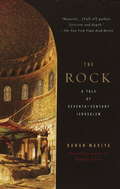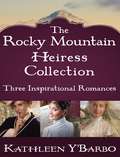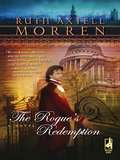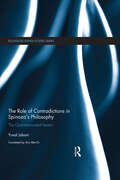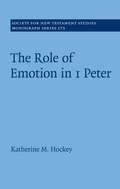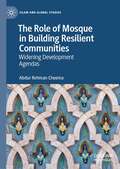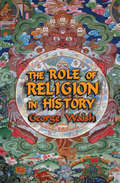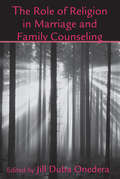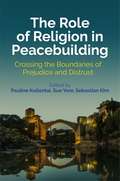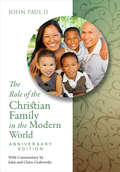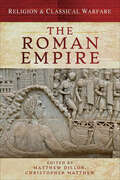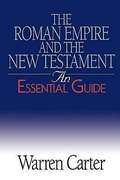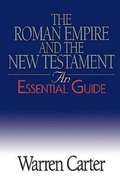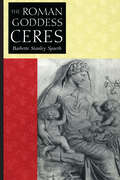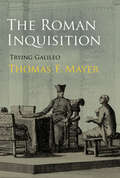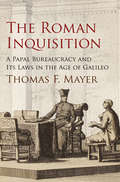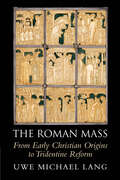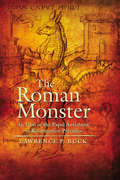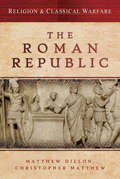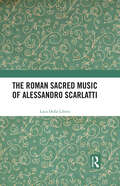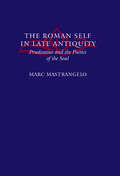- Table View
- List View
The Rock: A Tale of Seventh-Century Jerusalem
by Kanan MakiyaWhose rock is enshrined inside the golden Dome of Jerusalem? The rock of Moses or of Muhammad? Kanan Makiya gathers together the stories, legends, and beliefs that define the Rock—the place where Adam landed in his fall from Paradise and where Abraham attempted to sacrifice his first-born; where Solomon’s Temple stood and where Jesus preached; the rock from which Muhammad ascended to heaven—and transforms them into a narrative of novelistic depth and drama. This brilliantly imagined, historically based account of the building of the Dome of the Rock reconstructs the paths of the actual individuals whose spiritual journeys revolved around the seventh-century lore of the Rock. The chief protagonist is Ka’b al-Ahbar, a learned Jew who accepted the prophecy of Muhammad and who accompanied the caliph Umar ibn al-Khattab during his conquest of the Holy City. The story is narrated by Ka’b’s son, Ishaq, who years later is commissioned to design the first monument of Islam, the Dome of the Rock. As he imagines the construction of the Dome—and the complex reasons behind its creation—Makiya gives us a meditation on the common terrain of the world’s three great monotheistic religions and a remarkable investigation into what the Rock symbolizes—beyond its various stories and names, beyond even the three faiths at whose heart it sits.
The Rocky Mountain Heiress Collection: Three Inspirational Romances: The Confidential Life of Eugenia Cooper, Anna Finch and the Hired Gun, The Inconvenient Marriage of Charlotte Beck
by Kathleen Y'BarboTake a trip back to the nineteenth-century Wild West in these three inspirational romance novels, attractively priced and packaged as an eBook omnibus. Kathleen Y'Barbo's The Rocky Mountain Heiress Collection includes the rollicking romances of three amazing young women; an adventure-seeking heiress pretending to be a governess to go west, a feisty well-to-do society girl longing to become a journalist and chase the story of a lifetime, and the millionaire's daughter who is being asked to marry for the good of the family business . Fans of westerns will find themselves transported to frontier Colorado, and into stories with independent heroines, adventure, love, and ambition. ABOUT The Confidential Life of Eugenia Cooper Roman Holiday meets Mary Poppins in this Gilded Age tale of Eugenia "Gennie" Cooper, a New York socialite who takes advantage of a rare opportunity to step into the world of the dime novels she secretly loves. From the splendor of Fifth Avenue's mansions to the gilded homes of Denver silver barons and the rugged Leadville mines, Gennie's adventure as a governess soon becomes a love story despite the rocky start she has with widower Daniel Beck and his daughter Charlotte. ABOUT Anna Finch and the Hired Gun Anna Finch's father desperately wants to marry her off, but Anna's not having much success, mostly because she's much better at the written word than the spoken word. When she's around an eligible man, she becomes completely tongue-tied. It doesn't help that the awful man at the newspaper taunts her with constant mentions in his "Perish the Thought" gossip column. When Anna encounters the infamous lawman and outlaw Wyatt Earp, she sees her chance to finally achieve her dream of becoming a reporter. In this capacity, she finds love and trouble in equal measure when she convinces the dying gunfighter Doc Holliday to tell her his story. Her freedom to meet with Holliday is hampered, however, by Pinkerton agent Jeb Sanders, who's been hired to keep an eye on her--and keep her away from nobleman and notorious playboy Edwin Beck. Once Jeb realizes what Anna's up to, his annoyance at being forced to babysit a rich girl is swamped by his need to exact revenge on Doc Holliday. As the reporter and the detective get more tangled in Doc Holliday's story and each other, will their opposing goals tear them apart--or bring them together? ABOUT The Inconvenient Marriage of Charlotte Beck Charlotte Beck wants to go to college, but her father would rather she get married and spend her days painting. Alex Hambly's aristocratic family is in financial straits, and he has two options: either sell off the family's Colorado silver mine or marry a rich, American heiress. Charlotte's father makes them a deal: he'll allow Charlotte to go to college and be the instrument of Alex's financial salvation on one condition--that they agree to get married. Seeing no way out, Charlotte and Alex find themselves engaged. They agree that they'll have the marriage annulled as soon as possible and go back to their own lives. Except Alex isn't sure he wants the annulment. He sets out to woo his wife for real, and Charlotte suddenly finds that her marriage has become very inconvenient indeed.
The Rogue's Redemption
by Ruth Axtell MorrenOnly she could redeem him. . . He was tall and dark with eyes as blue as cobalt. In a glittering London ballroom Miss Hester Leighton saw a man who interested her more than anyone she'd met since coming to town. A woman of deep faith, Hester knew she should not keep company with Major Gerrit Hawkes, a jaded, penniless soldier haunted by nightmares of war. But their connection would not be denied. Hester was the only woman who'd ever made Gerrit feel truly worthy of love, and he would not lose her. Separated from her by her father--and an ocean--Gerrit must decide whether he will risk his life and his soul to earn a home in Hester's arms forever.
The Rogue's Reform
by Marta Perry Regina ScottJerome Everard expected to inherit his wayward uncle's estate. Instead, all has gone to a secret daughter. Only by disproving his young cousin's claim can Jerome regain his rightful property. But instead, he finds himself drawn to her lovely governess, Adele Walcott-a woman who holds the key to all of his uncle's secrets.Adele's fortune is gone, along with her marriage prospects. Now she is devoted to securing her charge's happiness. When she meets Jerome, she dares to dream of love again. But after learning his true motives, that love comes to a test. Can she forgive his past and reform his heart...to make it hers forever?
The Role of Contradictions in Spinoza's Philosophy: The God-intoxicated heretic (Routledge Jewish Studies Series)
by Yuval JobaniSpinoza is commonly perceived as the great metaphysician of coherence. The Euclidean manner in which he presented his philosophy in the Ethics has led readers to assume they are facing a strict and consistent philosophical system that necessarily follows from itself. As opposed to the prevailing understanding of Spinoza and his work, The Role of Contradictions in Spinoza's Philosophy explores an array of profound and pervasive contradictions in Spinoza’s system and argues they are deliberate and constitutive of his philosophical thinking and the notion of God at its heart. Relying on a meticulous and careful reading of the Theological-Political Treatise and the Ethics, this book reconstructs Spinoza's philosophy of contradictions as a key to the ascending three degrees of knowledge leading to the Amor intellectualis Dei. Offering an exciting and clearly-argued interpretation of Spinoza’s philosophy, this book will interest students and scholars of modern philosophy and philosophy of religion, as well as Jewish studies. Yuval Jobani is Assistant Professor at the Department of Hebrew Culture Studies and the School of Education at Tel-Aviv University.
The Role of Emotion in 1 Peter (Society for New Testament Studies Monograph Series #173)
by Katherine M. HockeyIn this book, Katherine M. Hockey explores the function of emotions in the New Testament by examining the role of emotions in 1 Peter. Moving beyond outdated, modern rationalistic views of emotions as irrational, bodily feelings, she presents a theoretically and historically informed cognitive approach to emotions in the New Testament. Informed by Greco-Roman philosophical and rhetorical views of emotions along with modern emotion theory, she shows how the author of 1 Peter uses the logic of each emotion to value and position objects within the audience's worldview, including the self and the other. She also demonstrates how, cumulatively, the emotions of joy, distress, fear, hope, and shame are deployed to build an alternative view of reality. This new view of reality aims to shape the believers' understanding of the structure of their world, encourages a reassessment of their personal goals, and ultimately seeks to affect their identity and behaviour.
The Role of Jewish Feasts in John's Gospel
by Gerry WheatonIn the first three Gospels, Jesus rarely travels to Jerusalem prior to his final week. The Fourth Gospel, however, features Jesus' repeated visits to the city, which occur primarily during major festivals. This volume elucidates the role of the Jewish feasts of Passover, Tabernacles, and Dedication in John's presentation of Jesus. Gerry Wheaton examines the Gospel in relation to pertinent sources from the Second Temple and Rabbinic periods, offering a fresh understanding of how John appropriates the symbolic and traditional backgrounds of these feasts. Wheaton situates his inquiry within the larger question of Judaism in John's Gospel, which many consider to be the most anti-Semitic New Testament text. The findings of this study significantly contribute to the ongoing debate surrounding the alleged anti-Jewish posture of the Gospel as a whole, and it offers new insights that will appeal to scholars of Johannine theology, New Testament studies, and Jewish studies.
The Role of Mosque in Building Resilient Communities: Widening Development Agendas (Islam and Global Studies)
by Abdur Rehman CheemaThis book is about the role of the mosque in the aftermath of the 2005 earthquake in Pakistan. Disasters give rise to a situation where people from different parts of the world, quite unfamiliar with each other, come into contact to save lives, provide necessities such as food and shelter, rebuild homes and enable community recovery. During these challenging times, community-based religious institutions such as churches, mosques and temples are a practical choice for reaching people living nearby to fulfil their needs. The book shows the contributions of the mosque as a physical, spiritual and social place for improving the knowledge and practice of disaster risk reduction and management including the COVID-19 pandemic. It also illuminates the widening role of religion in development. The book reinforces the case for broader engagement with all community-based religious institutions. The book is of interest to academics in diverse fields including development studies, disaster studies, sociology, anthropology, religion, Asian studies, emergency and disaster management. It will also of interest to the professional staff of disaster management authorities, public sector, bilateral and multilateral aid allocation and implementing agencies and those of humanitarian organizations.
The Role of Religion in History
by George WalshThis comprehensive survey of religion and its profound effects on history provides a historical context for in-depth analysis of theological, social, and political themes in which religion plays a major role. George Walsh first traces the rise and impact of primitive religions. He looks at Indian traditions, including Hinduism, Buddhism, and Jainism and analyzes the Semitic tradition of Judaism and Christianity and the evolving conception of a personal God. He discusses the history and chief doctrines of Islam as well, with its fundamental respect for desert tribal values and its emphasis on both the authority of God and the brotherhood of believers. Walsh then compares Judaism and Christianity. He sees Judaism as marked by a profound ambivalence between the values of tribal, nomadic desert life and the values of urban civilization, individualism, and collectivism. Judaism is "this-worldly," but the Christian worldview is "other-wordly." Walsh closes with a timely discussion of the ethical, political, and economic teachings of the Judeo-Christian tradition, focusing specifically on their differing attitudes toward sex, reproduction, and marriage; their basic views of mind and body; and man's relation to God.
The Role of Religion in Marriage and Family Counseling (Routledge Series on Family Therapy and Counseling)
by Jill Duba OnederaReligion can play a vital role in the way people relate to each other, particularly with interpersonal dynamics within a family. The role of a couple or family’s religion(s) in the counseling room is no less important. This book provides practitioners with an overview of the principles of the major world religions, with specific focus on how each religion can influence family dynamics, and how best to incorporate this knowledge into effective practice with clients.
The Role of Religion in Peacebuilding: Crossing the Boundaries of Prejudice and Distrust
by Dan Cohn-Sherbok Pauline Kollontai Sue Yore Sebastian Kim Kjetil Fretheim Pan-Chui Lai Cosimo Zene Kevin P. Considine Revd Canon Dr Christopher Collingwood Daeseung Son Margaret R. Pfeil Sangduk Kim Jamal Khader Mary Grey David Emmanuel Singh Agustinus Sutiono Michael John Tilley Lasma Latsone Gboyega Michael Tokunbo Linden Bicket Jenifer M. BakerThe question 'who is my neighbour?' challenges the way we see ourselves as well as the way we see others. Especially in situations where we feel conflicted between our own self-identity and common identity within a wider society. Historically, religion has contributed to this inner conflict by creating 'us versus them' mentalities. Challenging this traditional view, this volume examines how religions and religious communities can use their resources, methodology and praxis to encourage peace-making. The book is divided into two parts - the first includes sources, theories and methodologies of crossing boundaries of prejudice and distrust from the perspectives of theology and religious studies. The second includes case studies of theory and practice to challenge prejudice and distrust in a conflict or post-conflict situation. The chapters are written by scholars, religious leaders and faith-motivated peace practitioners from various global contexts to create a diverse academic study of religious peace-building.
The Role of the Christian Family in the Modern World Anniversary Edition
by John Paul II Claire Grabowski John GrabowskiThis apostolic exhortation can be considered the Magisterium's most comprehensive explanation of the nature of the family, rooting the essence of that nature in love. It also summarizes St. John Paul II's theology of the body which can lead persons to an "ever deeper and more intense communion." (FC 18).This special anniversary edition includes the full text of the original document plus new commentary that will guide you through this important document.
The Roman Cult of Mithras: The God and His Mysteries
by Manfred ClaussFirst published in 2001. Routledge is an imprint of Taylor & Francis, an informa company.
The Roman Empire (Religion & Classical Warfare)
by Matthew Dillon & Christopher MatthewReligion was integral to the conduct of war in the ancient world and the Romans were certainly no exception. No campaign was undertaken, no battle risked, without first making sacrifice to propitiate the appropriate gods (such as Mars, god of War) or consulting oracles and omens to divine their plans. Yet the link between war and religion is an area that has been regularly overlooked by modern scholars examining the conflicts of these times. This volume addresses that omission by drawing together the work of experts from across the globe. The chapters have been carefully structured by the editors so that this wide array of scholarship combines to give a coherent, comprehensive study of the role of religion in the wars of the Roman Empire. Aspects considered in depth include: the Imperial cults and legionary loyalty; the army and religious/regional disputes; Trajan and religion; Constantine and Christianity; omens and portents; funerary cults and practices; the cult of Mithras; the Imperial sacramentum; religion & Imperial military medicine.
The Roman Empire and the New Testament: An Essential Guide
by Warren CarterAn indispensable introduction to Roman society, culture, law, politics, religion, and daily life as they relate to the study of the New Testament. The Roman Empire formed the central context in which the New Testament was written. Anyone who wishes to understand the New Testament texts must become familiar with the political, economic, societal, cultural, and religious aspects of Roman rule. Much of the New Testament deals with enabling its readers to negotiate, in an array of different manners, this pervasive imperial context. This book will help the reader see how social structures and daily practices in the Roman world illumine so much of the content of the New Testament message. For example, to grasp what Paul was saying about food offered to idols one must understand that temples in the Roman world were not "churches," and that they functioned as political, economic, and gastronomic centers, whose religious dealings were embedded within these other functions. Brief in presentation yet broad in scope, The Roman Empire and the New Testament: An Essential Guide will introduce students to the information and ideas essential to coming to grips with the world in which early Christianity was born.
The Roman Empire and the New Testament: An Essential Guide (Abingdon Essential Guides Ser.)
by Warren CarterAn indispensable introduction to Roman society, culture, law, politics, religion, and daily life as they relate to the study of the New Testament.The Roman Empire formed the central context in which the New Testament was written. Anyone who wishes to understand the New Testament texts must become familiar with the political, economic, societal, cultural, and religious aspects of Roman rule. Much of the New Testament deals with enabling its readers to negotiate, in an array of different manners, this pervasive imperial context. This book will help the reader see how social structures and daily practices in the Roman world illumine so much of the content of the New Testament message. For example, to grasp what Paul was saying about food offered to idols one must understand that temples in the Roman world were not “churches,” and that they functioned as political, economic, and gastronomic centers, whose religious dealings were embedded within these other functions.Brief in presentation yet broad in scope, The Roman Empire and the New Testament: An Essential Guide will introduce students to the information and ideas essential to coming to grips with the world in which early Christianity was born.
The Roman Goddess Ceres
by Barbette Stanley SpaethA thematic study of the Roman goddess of agriculture as represented in ancient culture from the prehistoric period to the Late Roman Empire.Interest in goddess worship is growing in contemporary society, as women seek models for feminine spirituality and wholeness. New cults are developing around ancient goddesses from many cultures, although their modern adherents often envision and interpret the goddesses very differently than their original worshippers did.In this thematic study of the Roman goddess Ceres, Barbette Spaeth explores the rich complexity of meanings and functions that grew up around the goddess from the prehistoric period to the Late Roman Empire. In particular, she examines two major concepts, fertility and liminality, and two social categories, the plebs and women, which were inextricably linked with Ceres in the Roman mind. Spaeth then analyzes an image of the goddess in a relief of the Ara Pacis, an important state monument of the Augustan period, showing how it incorporates all these varied roles and associations of Ceres. This interpretation represents a new contribution to art history. With its use of literary, epigraphical, numismatic, artistic, and archaeological evidence, The Roman Goddess Ceres presents a more encompassing view of the goddess than was previously available. It will be important reading for all students of Classics, as well as for a general audience interested in New Age, feminist, or pagan spirituality.
The Roman Inquisition
by Thomas F. MayerWhile the Spanish Inquisition has laid the greatest claim to both scholarly attention and the popular imagination, the Roman Inquisition, established in 1542 and a key instrument of papal authority, was more powerful, important, and long-lived. Founded by Paul III and originally aimed to eradicate Protestant heresy, it followed medieval antecedents but went beyond them by becoming a highly articulated centralized organ directly dependent on the pope. By the late sixteenth century the Roman Inquisition had developed its own distinctive procedures, legal process, and personnel, the congregation of cardinals and a professional staff. Its legal process grew out of the technique of inquisitio formulated by Innocent III in the early thirteenth century, it became the most precocious papal bureaucracy on the road to the first "absolutist" state.As Thomas F. Mayer demonstrates, the Inquisition underwent constant modification as it expanded. The new institution modeled its case management and other procedures on those of another medieval ancestor, the Roman supreme court, the Rota. With unparalleled attention to archival sources and detail, Mayer portrays a highly articulated corporate bureaucracy with the pope at its head. He profiles the Cardinal Inquisitors, including those who would play a major role in Galileo's trials, and details their social and geographical origins, their education, economic status, earlier careers in the Church, and networks of patronage. At the point this study ends, circa 1640, Pope Urban VIII had made the Roman Inquisition his personal instrument and dominated it to a degree none of his predecessors had approached.
The Roman Inquisition: A Papal Bureaucracy and Its Laws in the Age of Galileo
by Thomas F. MayerWhile the Spanish Inquisition has laid the greatest claim to both scholarly attention and the popular imagination, the Roman Inquisition, established in 1542 and a key instrument of papal authority, was more powerful, important, and long-lived. Founded by Paul III and originally aimed to eradicate Protestant heresy, it followed medieval antecedents but went beyond them by becoming a highly articulated centralized organ directly dependent on the pope. By the late sixteenth century the Roman Inquisition had developed its own distinctive procedures, legal process, and personnel, the congregation of cardinals and a professional staff. Its legal process grew out of the technique of inquisitio formulated by Innocent III in the early thirteenth century, it became the most precocious papal bureaucracy on the road to the first "absolutist" state.As Thomas F. Mayer demonstrates, the Inquisition underwent constant modification as it expanded. The new institution modeled its case management and other procedures on those of another medieval ancestor, the Roman supreme court, the Rota. With unparalleled attention to archival sources and detail, Mayer portrays a highly articulated corporate bureaucracy with the pope at its head. He profiles the Cardinal Inquisitors, including those who would play a major role in Galileo's trials, and details their social and geographical origins, their education, economic status, earlier careers in the Church, and networks of patronage. At the point this study ends, circa 1640, Pope Urban VIII had made the Roman Inquisition his personal instrument and dominated it to a degree none of his predecessors had approached.
The Roman Mass: From Early Christian Origins to Tridentine Reform
by Uwe Michael LangThis volume offers a new, synthetic overview of the structure and ritual shape of the Roman Mass from its formative period in late antiquity to its post-Tridentine standarisation. Starting with the Last Supper and the origins of the Eucharist, Uwe Michael Lang constructs a narrative that explores the intense religious, social, and cultural transformations that shaped the Roman Mass. Lang unites classical liturgical history with insights from a variety of other disciplines that have drawn attention to the ritual performance and reception of the mass. He also presents liturgical developments within the broader historical and theological contexts that affected the celebration and experience of the sacramental rite that is still at the heart of Catholic Christianity. Aimed at scholars from a broad swathe of subjects, including religious studies, history, art history, literature, and music, Lang's volume serves as a comprehensive history of the Roman Mass over the course of a millenium.
The Roman Monster: An Icon of the Papal Antichrist In Reformation Polemics (Early Modern Studies #13)
by Lawrence BuckIn December 1495 the Tiber River flooded the city of Rome causing extensive drowning and destruction. When the water finally receded, a rumor began to circulate that a grotesque monstrosity had been discovered in the muddy detritus—the Roman monster. The creature itself is inherently fascinating, consisting of an eclectic combination of human and animal body parts. The symbolism of these elements, the interpretations that religious controversialists read into them, and the history of the image itself, help to document antipapal polemics from fifteenth-century Rome to the Elizabethan religious settlement.This study examines the iconography of the image of the Roman monster and offers ideological reasons for associating the image with the pre-Reformation Waldensians and Bohemian Brethren. It accounts for the reproduction and survival of the monster's image in fifteenth-century Bohemia and provides historical background on the topos of the papal Antichrist, a concept that Philip Melanchthon associated with the monster. It contextualizes Melanchthon’s tract, "The Pope-Ass Explained," within the first five years of the Lutheran movement, and it documents the popularity of the Roman monster within the polemical and apocalyptic writings of the Reformation.This is a careful examination and interpretation of all relevant primary documents and secondary historical literature in telling the story of the origins and impact of the most famous monstrous portent of the Reformation era.
The Roman Monster: An Icon of the Papal Antichrist In Reformation Polemics (Early Modern Studies)
by Lawrence BuckIn December 1495 the Tiber River flooded the city of Rome causing extensive drowning and destruction. When the water finally receded, a rumor began to circulate that a grotesque monstrosity had been discovered in the muddy detritus—the Roman monster. The creature itself is inherently fascinating, consisting of an eclectic combination of human and animal body parts. The symbolism of these elements, the interpretations that religious controversialists read into them, and the history of the image itself, help to document antipapal polemics from fifteenth-century Rome to the Elizabethan religious settlement.This study examines the iconography of the image of the Roman monster and offers ideological reasons for associating the image with the pre-Reformation Waldensians and Bohemian Brethren. It accounts for the reproduction and survival of the monster's image in fifteenth-century Bohemia and provides historical background on the topos of the papal Antichrist, a concept that Philip Melanchthon associated with the monster. It contextualizes Melanchthon’s tract, “The Pope-Ass Explained,” within the first five years of the Lutheran movement, and it documents the popularity of the Roman monster within the polemical and apocalyptic writings of the Reformation.This is a careful examination and interpretation of all relevant primary documents and secondary historical literature in telling the story of the origins and impact of the most famous monstrous portent of the Reformation era.
The Roman Republic (Religion & Classical Warfare)
by Christopher Matthew Matthew DillonEssays exploring the role religion played in ancient Roman warfare, including destroying enemies’ gods, wartime ceremonies, and live burials.Religion was integral to the conduct of war in the ancient world and the Romans were certainly no exception. No campaign was undertaken, no battle risked, without first making sacrifice to propitiate the appropriate gods (such as Mars, god of War) or consulting oracles and omens to divine their plans. Yet the link between war and religion is an area that has been regularly overlooked by modern scholars examining the conflicts of these times. This volume addresses that omission by drawing together the work of experts from across the globe. The chapters have been carefully structured by the editors so that this wide array of scholarship combines to give a coherent, comprehensive study of the role of religion in the wars of the Roman Republic.Aspects considered in depth will include: declarations of war; evocation and taking gods away from enemies; dedications and ceremonies; the cult of the legionary eagle; the role of women in Republican warfare; omens and divination; live burials of people in times of military crisis; and the rituals of the Roman triumph.PraiseReligion & Classical Warfare: The Roman Republic“The authors take a novel approach in looking at military history of the Roman Republic in terms of the relationship between warriors and religion. The ancient world was driven to a high degree by religious belief, even to the point of commanders relying on seers to advise them on the eve of battle.—Very Highly Recommended.” —Firetrench “A work of meticulous and detailed scholarship.” —Midwest Book Review
The Roman Sacred Music of Alessandro Scarlatti
by Luca Della LiberaThis book offers an account of the sacred music written by Alessandro Scarlatti (1660-1725) in Rome, a city where the composer lived and worked for many years throughout his career. Using archival research, Luca Della Libera provides an overview of Scarlatti’s life and activities in Rome, addresses his connections with the institutions and patrons of the city, and analyses his Roman repertoire in comparison to the sacred music of other contemporary composers, demonstrating its unique characteristics. An appendix includes transcriptions of the archival sources connected with Scarlatti’s activity in Rome. The first major publication in English to address the sacred music repertoire of one of the major composers of the Italian Baroque, this book offers new insights into Scarlatti’s work and a valuable resource for researchers in musicology and early modern studies.
The Roman Self in Late Antiquity: Prudentius and the Poetics of the Soul
by Marc MastrangeloThe Roman Self in Late Antiquity for the first time situates Prudentius within a broad intellectual, political, and literary context of fourth-century Rome. As Marc Mastrangelo convincingly demonstrates, the late-fourth-century poet drew on both pagan and Christian intellectual traditions—especially Platonism, Vergilian epic poetics, and biblical exegesis—to define a new vision of the self for the newly Christian Roman Empire. Mastrangelo proposes an original theory of Prudentius's allegorical poetry and establishes Prudentius as a successor to Vergil. Employing recent approaches to typology and biblical exegesis as well as the most current theories of allusion and intertextuality in Latin poetry, he interprets the meaning and influence of Prudentius's work and positions the poet as a vital author for the transmission of the classical tradition to the early modern period. This provocative study challenges the view that poetry in the fourth century played a subordinate role to patristic prose in forging Christian Roman identity. It seeks to restore poetry to its rightful place as a crucial source for interpreting the rich cultural and intellectual life of the era.
